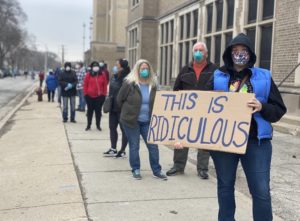3 Keys for Campaigns Adapting to Vote-By-Mail
A few weeks ago, voters in Wisconsin faced a difficult and troubling choice: risk their health and safety by voting in the state’s primary or sit out the election and silence their voices.
Powerful images poured out of Wisconsin showing undeterred voters lining up with face masks and attempting to social distance so they could cast their ballots.
This shot — instantly iconic — captured the difficult situation and the frustration of voters:

Many states will try to avoid the Wisconsin experience by postponing their primaries or transitioning from in-person voting to vote-by-mail and expanded absentee voting. But given the many divided state governments, the Trump administration’s opposition to vote-by-mail, a Supreme Court stacked with Trump appointees, and continued negativity from Republican leaders in Congress, we can expect more lawsuits, more chaos, and more confusion.
While the President continues to cast doubt on the legitimacy and reliability of voting by mail, the record tells a different story. Members of the military serving overseas vote by mail every election, without incident. And several states have radically expanded VBM in recent years. Take Washington state, where a comprehensive, statewide vote-by-mail system has been tested for several cycles and is currently administered by a Republican Secretary of State; voters trust the integrity of the process and appreciate a convenient voting experience that breaks down barriers to voting and encourages high turnout.
In the age of coronavirus, campaigns will need to pivot, adapt their voter contact strategies, and prepare for a vote-by-mail reality. Not every state will have a governor or state legislature that supports vote-by-mail; in many cases, campaigns will need to take the lead. Here are some lessons we can learn from the Washington model:
- Throw out the traditional calendars and begin early with education and GOTV planning.
In states that have not held vote-by-mail elections before, campaigns face big challenges: educating voters about how to vote, building trust in the process, and cutting through a crowded media environment to get the word out about their candidate or cause. Reaching voters now to start the conversation; listen to their fears, concerns, and priorities; and ensure they know how to cast a ballot will be more important than ever.In Washington state, campaigns performed a complete overhaul on voter contact and turnout planning. Gone is the final 96-hour push to get out the vote during the last weekend before Election Day. Now that aggressive GOTV effort begins a month out, with staff and volunteers targeting priority voters from the moment ballots arrive in mailboxes. Additionally, sophisticated campaigns are able to match their own turnout data against the publicly available state data to better understand who has already voted as the GOTV process continues, allowing for refined targeting to communities and constituencies on a day-to-day basis.Campaigns will need to build broader volunteer armies to turn out a larger number of voters while also considering the best ways to communicate on this revised turnout timeline. Beginning with voter registration through education on revised process and policy positions and finally with mobilization, campaigns need to consider the right mix of direct mail, digital, and TV spending. Importantly, they will also need to be nimble in targeting voters with most resonant messagings in the voting window, refining both the messaging and the voter targets as ballots are returned. - Hyperlocal information and trusted validators are critical.
Candidates and campaigns cannot wait to let their opponents frame the issue of voting access — they need to start talking to their audiences now to build trust. We know there will be high levels of disinformation surrounding the 2020 election. Russia meddled in the 2016 election and is doing the same thing this cycle to boost Trump. The RNC and Trump campaign will not hesitate to muddy the waters about the potential transition to vote-by-mail in races up and down the ballot to sow confusion. And the lack of a clear federal response to the voting challenges posed by coronavirus opens the door to more confusion in 2020.Deploying a strong paid and earned media strategy that relies on trusted messengers — including hyperlocal, trusted validators and micro influencers — will be crucial. The longer period of time around GOTV and the expanded contact universe provides opportunities for campaigns to ensure their messages reach the right people at the right times. Leaning on strong, local leadership to provide validation, information, and confidence in the system will also be critical. - Campaigns need to take extra steps to reach out to marginalized groups.
Black and brown communities already face barriers to voting, whether it’s burdensome ID requirements, reduced early voting periods, or purging of voter records. And the Shelby v. Holder SCOTUS decision rolling back Article V of the Voting Rights Act — which required states with a history of voter suppression to pre-clear changes to their voting rights laws — has empowered many states to reduce voting access for political gains in recent cycles.The Leadership Conference on Civil and Human Rights, a leading civil rights organization, has raised the alarm about the impact of the transition to vote-by-mail on voting access for historically marginalized groups. To be successful, vote-by-mail efforts must be properly funded. The Brennan Center for Justice estimates that states will need up to $1.4 billion to ensure they have resources to ensure vote-by-mail is accessible to all Americans, including the cost of ballot printing, postage, electronic ballot request systems, staffing, processing, and more. Absent robust funding at the state or federal level, campaigns need to take the extra step to invest in outreach to racially marginalized groups — whether that’s additional field organizers, more political staffers with strong community connections, or an increased paid media budget to reach people online.